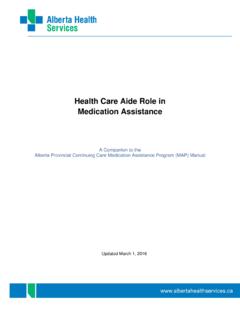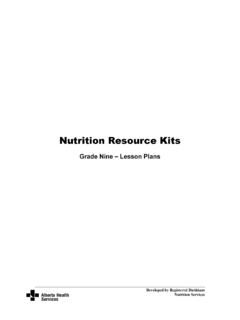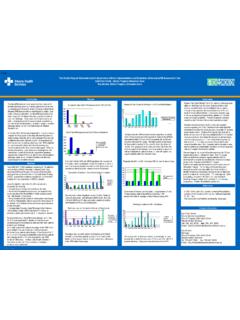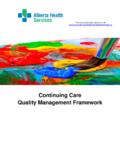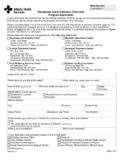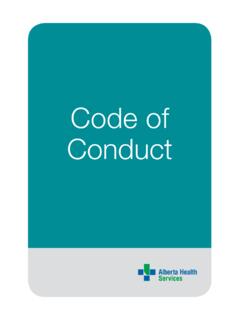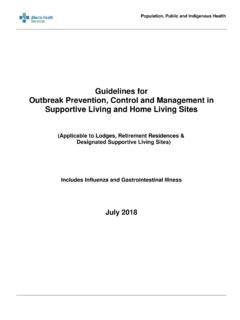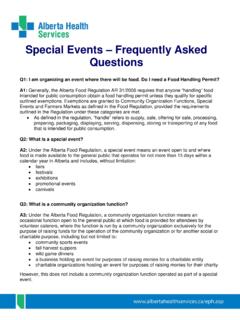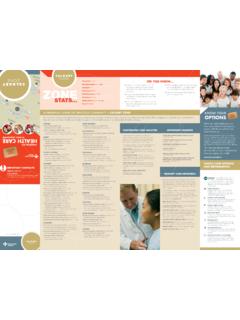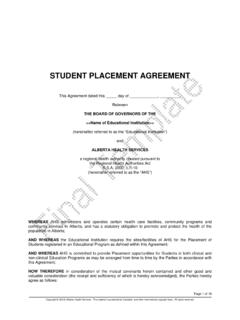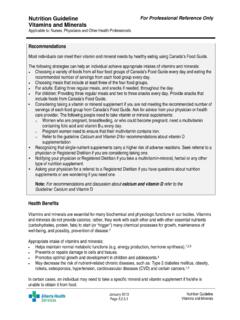Transcription of Nutrition Guideline Healthy Infants and Young Children: Iron
1 Nutrition Guideline For Professional Reference Only Healthy Infants and Young Children Iron Applicable to: Nurses, Physicians and Other Health Professionals Recommendations Infants who are not exclusively breastfed should be offered a commercial infant formula until 9 12. months of age. When complementary foods are introduced around 6 months of age, iron-rich foods should be emphasized: o An infant 's first complementary foods should be iron-rich ( infant cereals with iron, meat, poultry, fish and meat alternatives such as legumes, eggs and tofu). o An iron-rich food should be offered at each meal. o A variety of iron-rich foods should be offered. o Commercial infant cereal with iron should be offered. Homemade infant cereal is not recommended. Iron-rich foods should continue to be offered throughout the second year of life and beyond. Introduction of milk before 9 12 months of age is not recommended. It is recommended that children 1 year of age and older drink 2 cups (500 mL) of milk each day.
2 Drinking more than this may displace iron-rich foods in their diet. Routine iron supplementation is not recommended as a preventative measure against iron deficiency for Healthy term Infants . Health Benefits: Iron is an important mineral involved in oxygen transportation in the In infancy, iron is an essential nutrient for normal Iron is the most common single nutrient deficiency in the ,3 Although iron deficiency is higher in developing countries, it is still a concern in developed countries such as Universal screening for iron deficiency is not currently done in Canada; therefore, national prevalence rates are not available. One Canadian study that looked at 428 Healthy Infants 8 15 months of age found that more than one third ( ) had iron depletion and had iron deficiency anemia (IDA).5 In another Canadian study, researchers analyzed blood from 1647 children 1 6 years of age for iron deficiency and Total prevalence of iron deficiency and IDA was and Iron deficiency in Canadian Aboriginal Infants 4 18 months of age has been reported at Studies in other developed countries have also found variable rates ( 27%) of iron deficiency in otherwise Healthy Infants and ,8,9.
3 Considering the current research indicating that iron deficiency is present in Canada, it is important to provide recommendations to prevent iron deficiency in Infants and Young children. Note: This Guideline refers to Healthy term Infants . For information on iron and preterm Infants refer to the Nutrition Guideline : Introduction of Complementary Foods for Preterm Infants . January 2016 Nutrition Guideline : Healthy Infants and Young Children Page Iron Nutrition Guideline For Professional Reference Only Healthy Infants and Young Children Iron Applicable to: Nurses, Physicians and Other Health Professionals Key Questions What are the risk factors for iron deficiency in Infants and children? Factors associated with increased risk of iron deficiency in Infants and Young children include:1,2,3,4,10. maternal low iron status gestational diabetes premature birth low birth weight late introduction of complementary foods low intake of iron-rich complementary foods early cow's milk introduction high cow's milk intake prolonged bottle use immigrant status low socioeconomic status What are the symptoms of iron deficiency in Infants and children?
4 Iron deficiency occurs on a continuum with symptoms including pallor, poor appetite and irritability; growth faltering and delayed development are often not apparent until a deficiency is IDA in infancy is associated with poor cognitive and behavioural performance in Even after iron status is corrected, certain cognitive deficits may persist into adulthood,1,2 although study findings have been One study found that adolescents who had iron deficiency in infancy scored lower on measures of overall mental and motor functioning compared to those who were iron sufficient in Additionally, adolescents who had iron deficiency in infancy showed more anxiety/depression, social problems and attention problems. 12. How much iron do Infants and children need? Infants are born with iron stores accumulated from the third trimester of Most Healthy term Infants are born with sufficient stores of iron to meet their iron needs until they are approximately 6 months ,13,14. Around 6 months of age, iron stores have been utilized and external sources of iron (from food) are ,3,13,14,15 Because of the rapid growth that occurs between 6 and 24 months of age, iron requirements per kilogram of body weight are higher than during any other period of ,3.
5 The Dietary Reference Intakes (DRI) are a common set of reference values (on macro and micro nutrients). based on scientifically grounded relationships between nutrient intakes and indicators of adequacy, as well as the prevention of chronic diseases, in apparently Healthy populations. 16 The DRI recommendations include a Recommended Dietary Allowance (RDA) for iron. This refers to the average daily iron intake level sufficient to meet the needs of almost all Healthy individuals in a particular life Table 1 provides the RDA for iron for Healthy term Infants and Young January 2016 Nutrition Guideline : Healthy Infants and Young Children Page Iron Nutrition Guideline For Professional Reference Only Healthy Infants and Young Children Iron Applicable to: Nurses, Physicians and Other Health Professionals Table 1. Recommended Dietary Allowance (RDA) for Iron1. Age RDA. 0 6 months mg/day*. 7 12 months 11 mg/day 1 3 years 7 mg/day**. 4 8 years 10 mg/day**. * Adequate Intake (AI) rather than RDA; used when an RDA cannot be determined ** The requirement for iron is times higher for vegetarians due to the lower bioavailability of iron from a vegetarian diet.
6 1. For the first 6 months of life, iron requirements are based on iron amounts in the average amount of breastmilk consumed ( L/day).1 The RDA for 7 12 month olds was calculated assuming relatively low meat consumption (10% bioavailability), whereas the RDA for 1 3 and 4 8 year olds were calculated assuming a mixed diet (18% bioavailability).1. How much iron is absorbed from breastmilk? Bioavailability refers to the accessibility of a nutrient to participate in metabolic and/or physiological Only some of the iron in food is considered bioavailable and is able to be absorbed and used by the body. Breastmilk contains about mg/L of iron and 45 100% of this iron is Bioavailability of iron from breastmilk decreases to approximately 15% once complementary foods have been Why is it important for Infants who are not exclusively breastfed to be fed commercial infant formula? All commercial infant formulas must undergo a full safety and nutritional quality assessment by Health Canada before they can be Homemade infant formula is nutritionally incomplete (low in iron, essential fatty acids and other essential nutrients) and may deliver a high renal solute load, which could affect renal function with prolonged ,19,20.
7 Commercial infant formulas contain adequate iron ( 4 mg/L) for most Healthy term Infants . In 1994, Moffatt et al, randomized high risk Canadian Infants with non-fortified ( mg iron/L) and fortified ( mg iron /L) Iron status was tested at 6, 9, 12 and 15 months. Iron depletion rates, defined as two or more low ferritin values (<10 g/L), were and for Infants consuming non-fortified and fortified formula, respectively. A homemade infant formula made with cow's milk, goat's milk or a plant-based beverage, without the addition of iron supplementation would have <1mg iron/L. Therefore, it could be speculated that the risk of iron depletion would be even higher if Infants were solely fed homemade infant formula. How much iron is in commercial infant formula? Commercial infant formulas are regulated under the Canadian Food and Drug infant formulas for sale in Canada contain 4 13 mg iron/L,17 which is considered adequate for most Healthy term It is prudent to recommend that Infants at risk of iron deficiency consume infant formula with iron levels at the higher end of the Although commercial infant formulas contain more iron than breastmilk, only 10% of the iron is January 2016 Nutrition Guideline : Healthy Infants and Young Children Page Iron Nutrition Guideline For Professional Reference Only Healthy Infants and Young Children Iron Applicable to: Nurses, Physicians and Other Health Professionals Does the iron in infant formulas cause any gastrointestinal side effects?
8 Taking supplemental iron may have gastrointestinal side effects;22 however, research indicates that Infants fed iron-fortified formulas are no more likely to suffer gastrointestinal side effects than Infants fed non-fortified formulas. No differences have been observed in the number of stools, consistency of stools, incidence of gas, colic, or spitting up between Infants fed iron-fortified (12 mg/L) and those fed non-fortified (1 mg/L). ,24,25 The stool colour is the only notable difference. Stools were light brown when Infants consumed non-fortified formula ( mg/L) compared to dark brown, black, or greenish when Infants consumed iron- fortified formula (12 mg/L).26 Practically speaking, stool patterns vary from child to child. A change in formula or introducing new foods can affect stool patterns. For more information on constipation, refer to the Nutrition Guideline : Healthy Infants and Young Children: Management of Constipation What are some examples of iron-rich complementary foods?
9 Iron requirements increase substantially from mg/day for Infants birth to 6 months of age, to 11 mg/day for Infants 7 12 months of It is important that an infant 's first complementary foods be iron-rich to help meet their increased Iron-rich complementary foods include infant cereals with iron, meat, poultry, fish and meat alternatives such as legumes (dried beans and peas, lentils, chickpeas), eggs and tofu. What impacts iron absorption from complementary foods? Iron bioavailability (ability to be absorbed and used by the body) is impacted by both iron status of the individual and by Iron is present in food as either heme iron, found in meat, poultry and fish, or as non-heme iron, which is found in both plant ( legumes, vegetables, fruit, grains, nuts and iron-fortified grain products) and animal (eggs, meat, poultry, fish) The bioavailability of heme iron (approximately 20%) is only slightly influenced by dietary factors and is substantially higher than it is in non-heme iron sources (approximately 5%).
10 1. The absorption of non-heme iron is strongly influenced by its interaction with other meal Inhibitors include phytates (found in grain products and legumes), polyphenols (found in vegetables, fruit, some cereals and legumes) and Enhancers include ascorbic acid (vitamin C) and heme iron sources (meat, poultry, fish).27. Because iron absorption is so complex and variable, it is not practical for health professionals to educate parents on all of the potential contributing factors. However, there are a few simple strategies that parents can focus on to help enhance iron absorption for their child: January 2016 Nutrition Guideline : Healthy Infants and Young Children Page Iron Nutrition Guideline For Professional Reference Only Healthy Infants and Young Children Iron Applicable to: Nurses, Physicians and Other Health Professionals When meat and non-heme iron sources are eaten together, the meat has been shown to enhance the absorption of non-heme iron by 150%.
